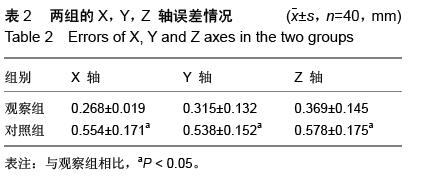| [1] 时光辉,任春富,杨中锐,等.数字化快速成型种植导板在上前牙区种植的临床应用研究[J].中国实用口腔科杂志, 2013,(9):532-534.
[2] 李瑛,张景慧,钱毅超,等.上前牙固定式树脂平面导板对白细胞介素-1β和白细胞介素-6的影响[J].包头医学院学报, 2013,29(6):33-36.
[3] Reis A, Higashi C, Loguercio AD, et al. Re- anatomization of anterior eroded teeth by stratification with direct composite resin. J Esthet Restor Dent. 2009;21(5):304-316.
[4] Schwartz Arad D, Ashkenazi M. Treatment options of untreatable traumatized anterior maxillary teeth for future use of dental implantation. Implant Dent. 2004;13(2): 120-128.
[5] 田美玉,张静,钱红,等.平面导板配合"T"型曲矫治成人安氏Ⅰ类深覆(牙合)重造的疗效分析[J].中国美容医学,2010, 19(1): 88-90.
[6] Santos-Filho PCF, Veríssimo C, Soares PV, et al. Influence of ferrule, post system, and length on biomechanical behavior of endodontically treated anterior teeth. J Endod. 2014;40(1):119-123.
[7] 徐亚文.下颌前牙切代帽联冠式斜导矫治替牙期牙性反牙合的初步探讨[J].临床口腔医学杂志,2014,(6): 321-321.
[8] 张守银,赵斌.上颌应用垂直曲加力单位弓丝联合下颌前牙平面导板矫治前牙反(牙合)[J].实用医技杂志,2004,11(12): 1055-1055.
[9] Vera C, De Kok IJ, Reinhold D, et al. Evaluation of buccal alveolar bone dimension of maxillary anterior and premolar teeth: a cone beam computed tomography investigation. Int J Oral Maxillofac Implants. 2012;27(6): 1514-1519.
[10] Jadhav G, Shah N, Logani A. Revascularization with and without platelet-rich plasma in nonvital, immature, anterior teeth: a pilot clinical study. J Endod. 2012;38(12): 1581-1587.
[11] Al-Omiri MK, Sghaireen MG, Alzarea BK, et al. Quantification of incisal tooth wear in upper anterior teeth: Conventional vs new method using toolmakers microscope and a three-dimensional measuring technique. J Dent. 2013;41(12):1214-1221.
[12] Jindal S, Jindal R, Mahajan S, et al. In vitro evaluation of the effect of post system and length on the fracture resistance of endodontically treated human anterior teeth. Clin Oral Invest. 2012;16(6):1627-1633.
[13] Isa ZM, Tawfiq OF, Noor NM, et al. Regression methods to investigate the relationship between facial measurements and widths of the maxillary anterior teeth. J Prosthet Dent. 2010;103(3):182-188.
[14] Cunningham BW, Hu N, Zorn CM, et al. Comparative fixation methods of cervical disc arthroplasty versus conventional methods of anterior cervical arthrodesis: serration, teeth, keels, or screws? J Neurosurg Spine. 2010;12(2):214-220.
[15] Mancini M, Felici R, Conte G, et al. Accuracy of three electronic apex locators in anterior and posterior teeth: an ex vivo study. J Endod. 2011;37(5):684-687.
[16] 张怡,邹敬才,刘芳霞,等.固定矫治器加平面导板在前牙外伤治疗中的应用[J].中国美容医学杂志,2001,10(2): 148-149.
[17] 张俊杰,陈宇强,王春明,等.采用Edgewise和平面导板联合治疗深覆(牙合)30例[J].武警医学院学报,2008,17(2): 131-132.
[18] 陈睿,冷卫东,罗志晓,等.方丝弓结合上颌前牙平面导板治疗深覆(牙合)的临床观察[J].口腔医学研究,2006,22(3): 330-333.
[19] Corbett IP, Jaber AA, Whitworth JM, et al. A comparison of the anterior middle superior alveolar nerve block and infraorbital nerve block for anesthesia of maxillary anterior teeth. J Am Dent Assoc. 2010;141(12):1442-1448.
[20] Aminabadi NA, Farahani RM. The efficacy of a modified omega wire extension for the treatment of severely damaged primary anterior teeth. J Clin Prosthet Dent. 2009;33(4):283-288.
[21] Bartlett D, Sundaram G, Moazzez R, et al. Trial of protective effect of fissure sealants, in vivo, on the palatal surfaces of anterior teeth, in patients suffering from erosion. J Dent. 2011;39(1):26-29.
[22] Khajehahmadi S, Rahpeyma A, Bidar M, et al. Vitality of intact teeth anterior to the mental foramen after inferior alveolar nerve repositioning: Nerve transpositioning versus nerve lateralization. Int J Oral Maxillofac Surg. 2013;42(9):1073-1078.
[23] 徐春华.摇椅弓结合上颌前牙平面导板在打开咬合中的临床应用[J].安徽医药,2012,16(11):1625-1626.
[24] 李瑛,刘鹏霞,李蔚,等.上前牙固定式树脂平面导板对龈沟液及牙周指标的影响观察[J].中国冶金工业医学杂志, 2013,30(6):680-681.
[25] 周文功.上颌平面导板在方丝弓矫治器打开咬合中的临床应用[J].口腔医学,2008,28(2):105-106.
[26] Gondim E Jr, Gomes BP, Ferraz CC, et al.Effect of sonic and ultrasonic retrograde cavity preparation on the integrity of root apices of freshly extracted human teeth: scanning electron microscopy analysis. J Endod. 2002; 28(9):646-650.
[27] Ahn HW, Moon SC, Baek SH, et al. Morphometric evaluation of changes in the alveolar bone and roots of the maxillary anterior teeth before and after en masse retraction using cone-beam computed tomography. Angle Orthod. 2013;83(2):212-221.
[28] Jung MS, Lee SP, Kim GT, et al. Three-dimensional analysis of deciduous maxillary anterior teeth using cone-beam computed tomography. Clin Anat. 2012; 25(2):182-188.
[29] 颉克茗.固定矫正器结合下颌联冠斜面导板在矫治前牙内倾性深覆的早期应用[J].口腔正畸学,2001,8(z1):24.
[30] 詹佳,洪虓,童树友,等.三维影像配合手术导板在口腔种植中的美学应用[J].中国美容医学,2013,22(2):255-258.
[31] Memarpour M, Shafiei F. Restoration of primary anterior teeth using intracanal polyethylene fibers and composite: an in vivo study. J Adhesive Dent. 2013;15(1):85-91.
[32] Varjão FM, Nogueira SS. Correlating the curve distance between the distal of the canines to the combined width of the six anterior teeth when selecting denture teeth for different ethnic groups. J Prosthet Dent. 2012;107(6): 400-404.
[33] Sülün T, Sakar O, Bilhan H, et al. The effect of mandibular anterior teeth on the hypermobile tissue in the anterior part of the maxilla. Arch Gerontol Geriatr. 2012;55(1):12-15.
[34] Na J, Lee BH, Baek JH, et al. Optical approach for monitoring the periodontal ligament changes induced by orthodontic forces around maxillary anterior teeth of white rats. Med Biol Eng Comput. 2008;46(6):597-603.
[35] 卢红飞,艾虹,麦志辉,等.摇椅弓与上颌平面导板打开深覆(牙合)的临床对比研究[J].中山大学学报(医学科学版), 2007,28(z1):156-157.
[36] Cattaneo PM, Salih RA, Melsen B, et al. Labio-lingual root control of lower anterior teeth and canines obtained by active and passive self-ligating brackets. Angle Orthod. 2013;83(4):691-697.
[37] Heo W, Nahm DS, Baek SH, et al. En masse retraction and two-step retraction of maxillary anterior teeth in adult Class I women. A comparison of anchorage loss. Angle Orthod. 2007;77(6):973-978.
[38] Schoenbaum TR, Klokkevold PR, Chang YY, et al. Immediate implant-supported provisional restoration with a root-form pontic for the replacement of two adjacent anterior maxillary teeth: a clinical report. J Prosthetic Dent. 2013;109(5):277-282.
[39] Kim YK, Kwon EY, Cho YJ, et al. Changes in the vertical position of interdental papillae and interseptal bone following the approximation of anterior teeth. Int J Periodontics Restorative Dent. 2014;34(2):219-224.
[40] 段斌.前牙斜面导板配合牵引矫治替牙期骨性反(牙合)[J].医药论坛杂志,2006,27(20):113-113. |
.jpg)



.jpg)
.jpg)
.jpg)